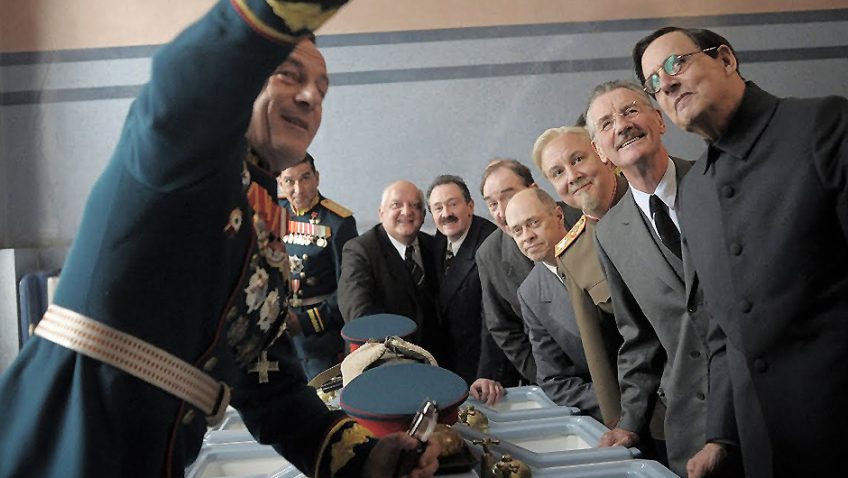Robert Tanitch reviews the latest DVDs
The Death of Stalin (Entertainment One). Stalin dies 5 March 1953. There is nobody to save him. All the best doctors are in the gulag or dead. A power struggle in the Kremlin follows during the political vacuum. The satire on the in-fighting, scheming, and back-stabbing is directed by Armando Iannucci and acted by an English and American cast larger than life. But the terror remains real. The contenders are brutal, neurotic, thuggish murderers. Are purges and executions a subject for comedy? Jeffrey Tambor (as Deputy Malenkov who has no idea what is going on) and Paddy Considine (as a frantic radio producer worrying he might be executed) are very funny. But generally the farce, however outlandish, is so dark and so chilling that it is not funny at all. Steve Buscemi is Khrushchev. Jason Isaacs is Zhukov. Simon Russell Beale’s Beria is a terrifying monster.
Breathe (STX entertainment). “I don’t want to just survive. I want to truly live.” The film, sincere, heartfelt, is a tribute to the love and courage of Robin and Diana Cavendish. At 27 Robin got polio. The doctors said he would die shortly and should remain hospitalised. Diana had other ideas. She took him home and became his nurse and carer. Andrew Garfield and Claire Foy, directed by Andy Serkis, put on a brave face. Garfield has a massive smile and flashing eyes. There is one image which really shocks: a German clinic with patients stacked in tiers in iron-lungs. It looks like something out of a Sci-If horror movie.
Goodbye Christopher Robin (Fox Searchlight Pictures). A .A. Milne, a popular West End playwright, became famous world-wide when he published the Winnie-the-Pooh books in 1926 and 1928. Christopher Robin was based on his son (played by Will Tilston) who became a celebrity child. Simon Curtis concentrates on his awkward relationship with his dad (World War 1 veteran still suffering from shell-shock) and his mum who were both keen to exploit him in publicity stunts. He got on best with his nanny. The film takes its pictorial images directly from the original E. H. Shephard illustrations.
Journeyman (StudioCanal) is written, directed and acted by Paddy Considine. A middle-weight champion gets a massive head injury and lose mental and physical ability. He hits his wife and puts his baby daughter in the washing machine. Unable to cope, his wife leaves him and he tries to drown himself. His team mates rally round. I thought the film was going to be anti-boxing. Instead it ends with him going back to the club to teach young boxers. He bears no grudges. “I love boxing,” he says.
Hotel Salvation (BFI). Varanasi on the banks of the Ganges is the holy city many Indians choose to go to when they want to die. It is very easy. You book into a hotel for 15 days and if you are not dead by then you have to leave. You can stay on by changing your name every fortnight. The film, written and directed by Shubhashish Bhutiani, a remarkable film debut for a then 23-year-old, concentrates on the relationship between a 77-year-old (Lalit Behl) who thinks his time has come and his exasperated middle-aged son (Adil Hussain) who has to take time off work to accompany him. The performances are notable for their subtlety and the quiet humour with which death is faced.
Silence and Cry (Second Run). If you have seen and admired Miklós Jancsó’s The Round-Up and The Red and the White, you will be keen to see to see this bleak and powerful study of brutality on the Hungarian plains in 1919 when the communists were in power. The characters constantly circle each other in Jancso’s familiar and brilliant filmed long-takes. There are summary shootings. A Red army soldier takes refuge in a village where the White soldiers humiliate and torture a peasant; and they frame him, too, for a murder they have done. Originally released in 1968 it’s a sharp and poisonous political film and not surprisingly the Soviets banned it.
Shiraz (BFI) is a silent Indian film released in 1929 and directed by Franz Osten. Shot entirely on location and only with natural light, it tells the story of the Taj Mahal in Agra which was built as a memorial to Mumtaz Mahal who died in childbirth. A humble potter (Himansu Rai) adored her but he lost out to a dishy prince (Charu Roy). The potter narrowly escaped death (trampled by Elephant’s foot) when he was caught in the women’s quarters of the palace. In his blind old age he was the architect of the mausoleum. It’s all a lot of romantic fiction.
To learn more about Robert Tanitch and his reviews, click here to go to his website











